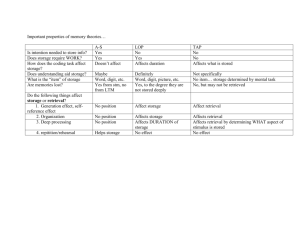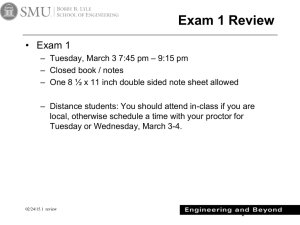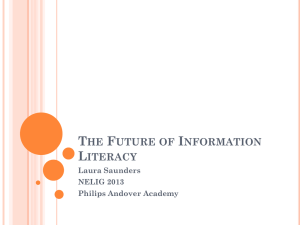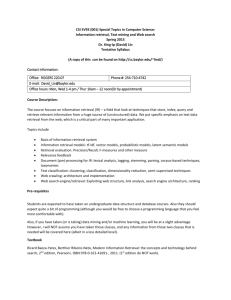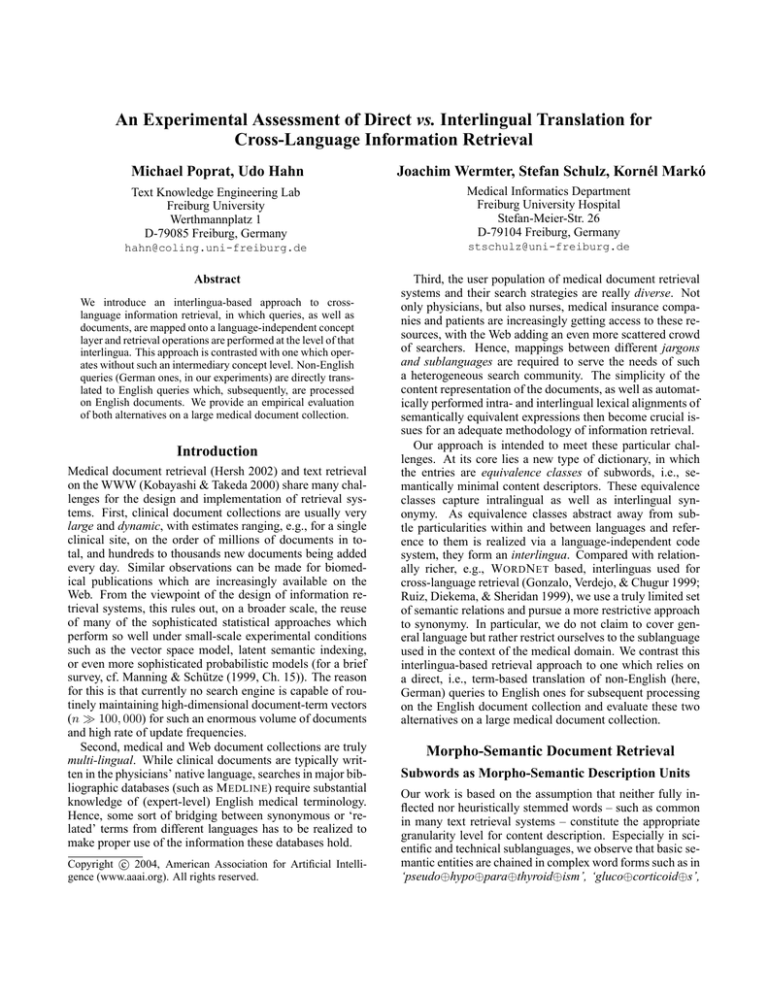
An Experimental Assessment of Direct vs. Interlingual Translation for
Cross-Language Information Retrieval
Michael Poprat, Udo Hahn
Joachim Wermter, Stefan Schulz, Kornél Markó
Text Knowledge Engineering Lab
Freiburg University
Werthmannplatz 1
D-79085 Freiburg, Germany
Medical Informatics Department
Freiburg University Hospital
Stefan-Meier-Str. 26
D-79104 Freiburg, Germany
hahn@coling.uni-freiburg.de
stschulz@uni-freiburg.de
Abstract
Third, the user population of medical document retrieval
systems and their search strategies are really diverse. Not
only physicians, but also nurses, medical insurance companies and patients are increasingly getting access to these resources, with the Web adding an even more scattered crowd
of searchers. Hence, mappings between different jargons
and sublanguages are required to serve the needs of such
a heterogeneous search community. The simplicity of the
content representation of the documents, as well as automatically performed intra- and interlingual lexical alignments of
semantically equivalent expressions then become crucial issues for an adequate methodology of information retrieval.
Our approach is intended to meet these particular challenges. At its core lies a new type of dictionary, in which
the entries are equivalence classes of subwords, i.e., semantically minimal content descriptors. These equivalence
classes capture intralingual as well as interlingual synonymy. As equivalence classes abstract away from subtle particularities within and between languages and reference to them is realized via a language-independent code
system, they form an interlingua. Compared with relationally richer, e.g., W ORD N ET based, interlinguas used for
cross-language retrieval (Gonzalo, Verdejo, & Chugur 1999;
Ruiz, Diekema, & Sheridan 1999), we use a truly limited set
of semantic relations and pursue a more restrictive approach
to synonymy. In particular, we do not claim to cover general language but rather restrict ourselves to the sublanguage
used in the context of the medical domain. We contrast this
interlingua-based retrieval approach to one which relies on
a direct, i.e., term-based translation of non-English (here,
German) queries to English ones for subsequent processing
on the English document collection and evaluate these two
alternatives on a large medical document collection.
We introduce an interlingua-based approach to crosslanguage information retrieval, in which queries, as well as
documents, are mapped onto a language-independent concept
layer and retrieval operations are performed at the level of that
interlingua. This approach is contrasted with one which operates without such an intermediary concept level. Non-English
queries (German ones, in our experiments) are directly translated to English queries which, subsequently, are processed
on English documents. We provide an empirical evaluation
of both alternatives on a large medical document collection.
Introduction
Medical document retrieval (Hersh 2002) and text retrieval
on the WWW (Kobayashi & Takeda 2000) share many challenges for the design and implementation of retrieval systems. First, clinical document collections are usually very
large and dynamic, with estimates ranging, e.g., for a single
clinical site, on the order of millions of documents in total, and hundreds to thousands new documents being added
every day. Similar observations can be made for biomedical publications which are increasingly available on the
Web. From the viewpoint of the design of information retrieval systems, this rules out, on a broader scale, the reuse
of many of the sophisticated statistical approaches which
perform so well under small-scale experimental conditions
such as the vector space model, latent semantic indexing,
or even more sophisticated probabilistic models (for a brief
survey, cf. Manning & Schütze (1999, Ch. 15)). The reason
for this is that currently no search engine is capable of routinely maintaining high-dimensional document-term vectors
(n 100, 000) for such an enormous volume of documents
and high rate of update frequencies.
Second, medical and Web document collections are truly
multi-lingual. While clinical documents are typically written in the physicians’ native language, searches in major bibliographic databases (such as M EDLINE) require substantial
knowledge of (expert-level) English medical terminology.
Hence, some sort of bridging between synonymous or ‘related’ terms from different languages has to be realized to
make proper use of the information these databases hold.
c 2004, American Association for Artificial IntelliCopyright gence (www.aaai.org). All rights reserved.
Morpho-Semantic Document Retrieval
Subwords as Morpho-Semantic Description Units
Our work is based on the assumption that neither fully inflected nor heuristically stemmed words – such as common
in many text retrieval systems – constitute the appropriate
granularity level for content description. Especially in scientific and technical sublanguages, we observe that basic semantic entities are chained in complex word forms such as in
‘pseudo⊕hypo⊕para⊕thyroid⊕ism’, ‘gluco⊕corticoid⊕s’,
or ‘pancreat⊕itis’ (‘⊕’ denotes the concatenation operator).
Domain-specific suffixes (e.g., ‘-itis’) and single-word compounds are even more accentuated in many languages other
than English, e.g., German. In order to deal with these phenomena, we introduce subwords as self-contained, semantically minimal units and motivate their existence by their
usefulness for document retrieval rather than by linguistic
considerations.
The minimality criterion for subwords is difficult to
define in a general way. Given the token ‘diaphysis’,
e.g., a linguistically plausible morpheme-style decomposition might lead to ‘dia⊕phys⊕is’. From a medical perspective, a coarser segmentation into ‘diaphys⊕is’ seems
much more reasonable, because the canonical linguistic
decomposition is far too fine-grained and likely to create many subword ambiguities. Comparable ‘low-level’
decompositions of semantically unrelated tokens such as
‘dia⊕lyt⊕ic’, ‘phys⊕iol⊕ogy’ postulate ‘dia’ and ‘phys’ as
morpheme-style units, which unwarrantedly will then match
‘dia⊕phys⊕is’, too. The (semantic) self-containedness of a
subword is, however, often supported by the existence of a
synonym, e.g., ‘shaft’ for ‘diaphys’.
Subwords are assembled in a multilingual lexicon and thesaurus. For each subword entry, special attributes of and
semantic relations between subwords are specified. The lexicon and the thesaurus are both constructed manually, based
on the following considerations:
• Subwords are registered, together with their attributes
such as language (English or German), subword type
(stem, prefix, suffix, invariant), comments and user metadata. Each lexicon entry is assigned a unique identifier
and one synonymy class (identified by a so-called equivalence class identifier, EC-ID), which contains this entry
as its only member.
• Synonymy classes which contain intralingual synonyms
and interlingual translations of subwords are fused. Intraand interlingual semantic equivalence are judged within
the context of medicine only.
• Semantic links between synonymy classes are added. We
subscribe to a shallow approach in which semantic relations are restricted to:
(i) a paradigmatic relation has-meaning, which relates one
ambiguous class to its specific readings, e.g.:
{head} ⇒ {kopf,zephal,caput,cephal} OR {leader, boss}.
(ii) a syntagmatic relation expands-to, which consists of
predefined segmentations for utterly short subwords, such
as {myalg} ⇒ {muskel,muscle} ⊕ {schmerz,pain}.
We refrain from introducing hierarchical relations between EC-IDs, because such links are acquired from
domain-specific vocabularies (Markó et al. 2003), e.g., the
Medical Subject Headings (M E SH 2001).
Maintenance of the Subword Repositories
The manual construction of the lexicon and the thesaurus has
consumed, up until now, about three person-years. The combined subword lexicon (release 08/2003) contains 43,165
entries, 21,237 for English1 and 21,928 for German. Given
our observations over time, we found a well-known logarithmic growth behavior as far as the number of subword
entries are concerned (Schulz & Hahn 2000). All of these
entries are related in the subword thesaurus by 17,805 equivalence classes. The average cardinality per equivalence class
is 2,42. Furthermore, there are 760 ambiguity links between
classes, together with 269 expansion links.
The process of lexicon construction is a challenging task
which requires in-depth knowledge of biomedical terminology. In the development workflow, the effects of lexicon
and thesaurus updates are immediately fed back to the developers using word lists to test both the segmentation and
the assignment of EC-IDs. Furthermore, a collection of parallel texts (abstracts of medical publications in English and
German as shown in Table 1) are used to detect errors in the
assignment of EC-IDs. In order to impose common policies
on the lexicon builders, we developed a maintenance manual
which contains 31 rules. The most critical tasks they cover
are listed below:
• The proper delimitation of subwords
‘compat⊕ibility’ vs. ‘compatib⊕ility’);
(e.g.,
• The decision whether an affix introduces a new meaning
which would justify a new entry (e.g., ‘neur⊕osis’ vs.
‘neuros⊕is’);
• Data-driven decisions, e.g., adding ‘-otomy’ as a synonym of ‘-tomy’ in order to block erroneous segmentations such as ‘nephrotomy’ into ‘nephr⊕oto⊕my’ (assuming, of course, that ‘-oto’ and ‘-my’ are already in the lexicon);
• The decision to exclude short stems from segmentation
(such as ‘my-’, ‘ov-’) in order to block false segmentations;
• The decision to locate the appropriate level of semantic
abstraction when defining equivalence classes, e.g., by
grouping {hyper-, high, elevate} into the same class;
• The decision which function words and affixes are excluded from indexing, such as ‘and’, ‘-ation’, ‘-able’, and
those which are not, e.g., ‘dys-’, ‘anti-’, ‘-itis’.
Morpho-Semantic Normalization
Table 1 illustrates how source documents from different languages are converted into an interlingual representation by a
three-step procedure. The first step deals with orthographic
normalization (cf. Table 1, second column). A preprocessor reduces all capitalized characters from input documents to lower-case characters and, additionally, performs
language-specific character substitutions (such as the normalization of German umlauts) in order to ease the matching
of (parts of) text tokens and entries in the lexicon.
The next step in the pipeline is concerned with morphological segmentation. The system decomposes the ortho1
Just for comparison, the size of W ORD N ET assembling the
lexemes of general English in the 2.0 version is on the order of
152,000 entries (http://www.cogsci.princeton.edu/
∼wn/doc.shtml, last visited on January 3, 2004)
Original Document
High TSH values suggest the
diagnosis of primary hypothyroidism while a suppressed
TSH level suggests hyperthyroidism.
Erhöhte
TSH-Werte
erlauben die Diagnose einer
primären Hypothyreose, ein
supprimierter TSH-Spiegel
spricht dagegen für eine
Schilddrüsenüberfunktion.
Orthographic Normalization
high tsh values suggest the diagnosis of primary hypothyroidism while a suppressed
tsh level suggests hyperthyroidism.
erhoehte tsh-werte erlauben
die diagnose einer primaeren
hypothyreose, ein supprimierter tsh-spiegel spricht dagegen fuer eine schilddruesenueberfunktion.
Morphological Segmentation
high tsh value s suggest the diagnos is of primar y hypo thyroid ism while a suppress ed
tsh level suggest s hyper thyroid ism.
er hoeh te tsh - wert e erlaub
en die diagnos e einer primaer
en hypo thyre ose, ein supprim iert er tsh - spiegel spricht
dagegen fuer eine schilddrues
en ueber funktion.
Semantic Normalization
#up# tsh #value# #suggest# #diagnost# #primar# #small# #thyre#
#suppress# tsh #nivell# #suggest#
#up# #thyre# .
#up# tsh - #value# #permit# #diagnost# #primar# #small# #thyre# ,
#suppress# tsh - {#mirror# #nivell#} #speak# #thyre# #up# #function# .
Table 1: Morpho-Semantic Indexing for English (row 1) and German (row 2) (Bold EC-IDs co-occur in both documents.)
graphically normalized input stream into a sequence of subwords (corresponding to the entries in the subword lexicon)
and lexical remainders (not in the lexicon) (cf. Table 1, third
column). The segmentation results are checked for morphological plausibility using a finite-state automaton in order
to reject invalid segmentations (e.g., segmentations without
stems or beginning with a suffix). If there are ambiguous
valid readings or incomplete segmentations (due to missing
entries in the lexicon), a series of heuristic rules are applied,
which prefer those segmentations with the longest match
from the left, the lowest number of unspecified segments,
etc. Whenever the segmentation algorithm fails to detect a
valid reading, the original word is restituted.
In the final step, semantic normalization, each subword
is substituted by its corresponding EC-ID (cf. Table 1, column 4). After that step, all synonyms within a language and
all translations of semantically equivalent subwords from
different languages are represented by the same code item
in that target representation. Composed terms (such as
‘myalg⊕y’) which are linked to their components by the
expands-to relation are substituted by the EC-IDs of their
components, in the same way as if this were performed by
the segmenter. Ambiguous classes, i.e., those related by
a has-meaning link to two or more classes, produce a sequence of their related EC-IDs (cf. the set notation in Table
1, column 4, row 2).2 The result generated by this pipeline is
a morpho-semantically normalized document in a languageindependent, interlingual representation.
Experimental Setting
Document Corpus
Our experiments were run on the O HSUMED corpus (Hersh
et al. 1994), which constitutes one of the standard IR
testbeds for the medical domain. It is a subset of the
M EDLINE database which contains bibliographic information (author, title, abstract, index terms, etc.) of life science and biomedicine articles. We only considered that
O HSUMED subset where each bibliographic unit contained
a title and an abstract field, and came up with a document
collection comprised of 233,445 texts. Our test collection
2
Work on a disambiguation metric is in progress.
is made of roughly 42 million tokens, and the average document length is 179.6 tokens (with a standard deviation of
76.4).
In the O HSUMED corpus, 106 queries are available (actually 105, because for one query no relevant documents could
be found), including associated relevance judgments. The
average number of query terms is 5.1 (with a standard deviation of 1.8). The following is a typical query: “Are there
adverse effects on lipids when progesterone is given with estrogen replacement therapy?”. In Figure 1, the result of processing this query and an extract of one retrieved document
illustrate the two alternative approaches we discuss. (Bold
terms co-occur in queries and the document fragment.)
The O HSUMED corpus contains only English-language
documents (and queries). This raises the question of how
this collection (or M EDLINE, in general) can be accessed
from other languages as well. It is a realistic scenario, because, unlike in sciences with English as a lingua franca,
among medical doctors native languages are still dominant in their education and everyday practice. In order
to solve this problem, medical practitioners might resort
to translating their native-language search problem to English with the help of current Web technology, e.g., an automatic translation service available in a standard Web search
engine. Its operation might be further enhanced by lexical ressources as available from the U.S. National Library
of Medicine in support of various non-English languages,
e.g. the UMLS Metathesaurus (U MLS 2003), which currently supports – with considerable differences in coverage – German, French, Spanish, Portuguese, Russian, and
many others. Relying on the quality of the translation, this
procedure then reduces the cross-language retrieval problem to a monolingual one. As an alternative, we introduce the Morpho-Semantic Indexing approach (henceforth,
MSI). Both of them will then be evaluated on the same
query and document set. As the baseline for our experiments, we provide a Boolean retrieval system operating with
the Porter stemmer (Porter 1980) and language-specific stop
word lists3 so that the system runs on (original) English documents with (original) English queries.
3
We used the stemmer available on http://www.snowball.tartarus.org (last visited on October, 16 2003). The
stop word lists contained 172 English and 232 German entries.
QTR Approach: Machine Translation and Bilingual Dictionaries
((E)nglish, (G)erman)
DocE
QueryG
MSI Approach: Language-Independent Morpho-Semantic Indexing
QueryE
Machine Translation:
Google Translator
Bilingual UMLS Dictionary
Filtering Stop Words
Orthographic
Rules (E/G)
Subword
Lexicon (E/G)
Filtering Stop Words
QueryG
DocE
Morpho-Semantic
Normalization
Subword
Thesaurus
DocMSI
Porter Stemmer
QueryMSI
Search Engine
Search Engine
Index (stems)
Index (EC-IDs)
Filtered and stemmed English documents (extract from 89270656):
Progestogen chosen addit estrogen replac import progestin advers influenc effect
oral estrogen lipid metabol
Filtered and stemmed English queries:
Q1:advers effect lipid progesteron given estrogen replac therapi
Automatically translated, filtered and stemmed German queries:
Q1:unwant side effect lipidstoffwechsel gift progesteron östrogenersatztherapi
Filtered and morpho-semantically indexed documents (extract from 89270656):
#progest# #choose# #overlay# #estrogen# #substitut# #important# #progest#
#advers# #influenc# #oro# #estrogen# #lipid# #metabol#
Filtered and morpho-semantically indexed German query:
Q1:#give# #non# #desir# #influenc# #collater# #lipid# #metabol# #dispensat#
#progest# #estrogen# #substitut# #therapeut#
Figure 1: Steps for Automatic Direct Translation (left) and Morpho-Semantic Indexing (right)
In our experiments, the original English queries were first
translated into German by medical experts (native speakers of German, with a very good mastery of both general
and medical English).4 In the second step, the manually
translated queries were re-translated into English using the
G OOGLE T RANSLATOR.5 Admittedly, this tool may not
be particularly suited to translate medical terminology (in
fact, 17% of the German query terms were not translated).
Hence, we additionally incorporated a bilingual lexeme dictionary derived from the UMLS Metathesaurus with about
26,000 German-English entries. If no English correspondence could be found, the terms were left untranslated (this,
finally, happened to 7% of the German query terms). Just as
in the baseline condition, the stop words were removed from
both the documents and the automatically translated queries.
The left side of Figure 1 visualizes this approach which we
refer to as QTR.
Alternatively, we probed the MSI approach. Unlike QTR,
the indexing of documents and queries using MSI (after stop
word elimination) yields a language-independent, semantically normalized index format. The right side of Figure 1
visualizes the basic computation steps for MSI.
4
The (human or machine) translation of native-language queries
into the target language of the document collection to be searched
is a standard experimental procedure in the cross-language retrieval
community (Eichmann, Ruiz, & Srinivasan 1998).
5
http://www.google.de/language tools, last visited on October 16, 2003.
Search Engine
For an unbiased evaluation of both approaches, we basically
used a simple Boolean search mechanism. The ranking algorithm keeps three different scores for each document. The
first is the number of the different query terms, q1 , q2 , . . . ,
qn , that match the document. For each query containing n
OR-ed terms, a document is assigned to one of n + 1 relevance levels (representing zero to n matches). The second
score determines, within each relevance level, the absolute
number of all occurrences of matching query terms within
the document. Third, building on experience from previous experiments, we incorporated an adjacency constraint
as an additional ranking criterion. The corresponding score
is based on moving a window of size n (the total number
of terms in the query) over the entire document. For each
window starting at a document term which matches a query
term, the extension of the window is searched for yet another
matching query term. If there is a match, the ‘window’ score
is incremented by ‘1’, iterating over the entire window size.
The window will then be moved to the next matching document term and the scoring procedure is started, again. The
effect of the ‘window’ scoring method is to significantly increase the score of clustered matches. This allows further
refinements in ranking, which become particularly important in the segmentation of complex word forms.6
6
Otherwise, a document containing ‘append⊕ectomy’ and
‘thyroid⊕itis’, and another one containing ‘append⊕ic⊕itis’ and
‘thyroid⊕ ectomy’ become indistinguishable after segmentation.
Retrieval Experiments
Three different test scenarios will be distinguished for our
retrieval experiments:
• QTR: In this condition set, German queries are automatically translated into English ones (using the G OOGLE
T RANSLATOR and the UMLS Metathesaurus), which are
Porter-stemmed after the translation. These queries are
evaluated on the Porter-stemmed document collection.
• MSI: This condition captures the automatic transformation of German queries into the language-independent
MSI code schema (plus lexical remainders). The entire
O HSUMED document collection is also submitted to the
MSI code generation procedure. Finally, the MSI-coded
queries are evaluated on the MSI-coded document collection, both at an interlingual representation level.
We use three types of measurement in comparing the performance of QTR and MSI. The first one (cf. Table 2 and its
visualization in Figure 2) is the average of the precision values at all eleven standard recall points (0.0, 0.1, 0.2, ..., 1.0).
We also calculate the average at the top two recall points (0.0
and 0.1). While this data was computed with consideration
to the first 200 documents under each condition, we also
calculated the exact precision scores for the top k ranked
documents, for various k ≤ 100 (cf. Table 3).
In Table 2, it is not surprising that the English-English
baseline performs best with an 11pt average of 0.14. The
German-English MSI result is almost on a par with the baseline (0.01 less (0.13)), whereas the German-English QTR
result is more than 0.05 points worse (0.09). This means
that the MSI approach achieved 93% of the baseline performance (quite a high score given CLIR standards), whereas
the QTR approach scored far lower (62%), resulting in a 31
percentage points difference between the two approaches.
In any case, it seems worth noting that at no recall point
QTR values were higher than MSI values (cf. also Figure
0.0
0.1
0.2
0.3
0.4
0.5
0.6
0.7
0.8
0.9
1.0
11pt avr
top 2 avr
% BASE
English
BASE
.4000
.3228
.2282
.1779
.1425
.1174
.0829
.0394
.0155
.0041
.0000
.1392
.3614
100.0
German
QTR
MSI
.2667 .3429
.1922 .3046
.1448 .2237
.1176 .1618
.0926 .1306
.0668 .1039
.0380 .0747
.0184 .0437
.0098 .0181
.0013 .0128
.0000 .0071
.0862 .1294
.2294 .3237
61.9
93.0
Table 2: Standard 11pt Precision/Recall Table
0.3
Precision
• BASEline: Our baseline is given by both the Porterstemmed English queries and the Porter-stemmed
O HSUMED document collection.
BASE
GE-MSI
GE-QTR
0.4
0.2
0.1
0.0
0.0
0.1* 0.2* 0.3* 0.4* 0.5* 0.6* 0.7*
Recall
0.8
0.9
1.0
Figure 2: Precision/Recall Graph for German-English
2). The recall points at which the MSI approach performed
significantly better than the QTR approach (at a significance
level of 0.05 according to the Wilcoxon two-sided paired
signed rank test) are marked with an asterisk in Figure 2.
For German-English 7 out of 11 measurement points (0.1
through 0.7) are significant.
Interesting from a realistic retrieval perspective is the average gain at the top two recall points. In Table 2, the
German-English condition yields a precision value of 0.32
(90% of the baseline) for MSI. However, there may be
considerable variation regarding the actual numbers behind
these levels of recall.
Standard Web users or medical decision-makers under
time pressure are more often interested in a few top-ranked
documents. Thus, the exact precision scores for these documents are more indicative of the performance of the two
approaches in a standard Web or medical retrieval context.
Table 3 reveals that at almost all document cut-off points
(we examined k = 5, 10, 15, 20, 30, 50, 100), the GermanEnglish MSI approach exceeds the others by more than 80%
of the English baseline and thus improves, on the average,
20 percentage points over the QTR approach.
top
5
10
15
20
30
50
100
English
BASE
.3429
.2867
.2622
.2405
.2057
.1623
.1158
German
QTR
MSI
.2133 (62.2%) .2952 (86.1%)
.1886 (65.8%) .2495 (87.0%)
.1638 (62.5%) .2165 (82.6%)
.1490 (62.0%) .1919 (79.8%)
.1302 (63.3%) .1717 (83.5%)
.1072 (66.1%) .1411 (86.9%)
.0726 (62.7%) .1038 (89.6%)
Table 3: Exact Precision Scores for Top k Documents
Related Work
The field of cross-language information retrieval (CLIR) is
divided into dictionary-based vs. corpus-based approaches
(Oard & Diekema 1998). Commercial or public-domain
translation programs are usually marked by poor support of
technical sublanguages. McCarley (1999) reports on a translation model, which incorporates both query and document
translation and outperforms either translation direction. His
approach, however, depends on the availability of large parallel corpora, which is mostly not the case for technical sublanguages. Therefore, dictionary-based approaches are favored for domain-specific CLIR. For medical terminology,
as well as for other sublanguages, non-specialized multilingual lexicons (based on W ORD N ET) also offer limited support only (Gonzalo, Verdejo, & Chugur 1999). Hence, we
were faced with the need to construct a multilingual medical
lexicon from scratch.
The success of dictionary-based CLIR largely depends on
the coverage of the lexicon, tools for conflating morphological variants, phrase and proper name recognition as well as
word sense disambiguation (Pirkola et al. 2001). We optimize for lexical coverage by designing the lexicon around
semantically relevant subwords of the medical domain. This
also helps us in dealing with morphological variation, including single-word compounds. The latter is a very common phenomenon, especially in German medical terminology (Schulz & Hahn 2000) and cannot be sufficiently treated
by dictionary-free techniques (Savoy 2002). This partially
explains the poor results for German in the S APHIRE medical text retrieval system which uses the UMLS Metathesaurus for semantic indexing (Hersh & Donohoe 1998).
The UMLS, together with W ORD N ET, is also the lexical
basis of the approach pursued by the M UCH M ORE project
(Volk et al. 2002). Here, concept mapping occurs after various steps of linguistic pre-processing, including lemmatization. Although very good results are communicated, these
are not comparable to ours because the authors use a homegrown document and query collection, as well as (not so reasonable) baselines diverging from ours.
Eichmann, Ruiz, & Srinivasan (1998) report on CLIR experiments for French and Spanish using the same test collection as we do (O HSUMED), and the UMLS Metathesaurus for query translation, achieving 71% of the baseline
for Spanish and 61% for French. With the vector space engine they employ, their overall 11pt performance (0.24) is far
above the one for the Boolean search engine (0.14) we use.
This, however, does not compromise our results, because
our experiments are aimed at comparing the performance of
two different CLIR methods and not at comparing different
search engine architectures. Moreover, our Boolean search
engine is more in line with current clinical and Web retrieval
engines and the requirements they have to fulfil.
Conclusions
We presented an interlingua approach to cross-language retrieval on a medical document collection. It uses a lexicon
composed of equivalence classes of subwords which capture intra- and interlingual synonymy. Compared with direct translation in which queries are automatically translated
by online translators, the interlingua approach outperformed
the direct approach reaching 93% of the English baseline.
Acknowledgments. This research is supported by the grant
KL 640/5-1 from Deutsche Forschungsgemeinschaft (DFG).
References
Eichmann, D.; Ruiz, M.; and Srinivasan, P. 1998. Crosslanguage information retrieval with the UMLS Metathesaurus. In Proceedings of the 21st Annual International
ACM SIGIR Conference, 72–80.
Gonzalo, J.; Verdejo, F.; and Chugur, I. 1999. Using
E URO W ORD N ET in a concept-based approach to crosslanguage text retrieval. Applied Artificial Intelligence
13(7):647–678.
Hersh, W., and Donohoe, L. 1998. S APHIRE International:
A tool for cross-language information retrieval. In Proceedings 1998 AMIA Annual Fall Symposium, 673–677.
Hersh, W.; Buckley, C.; Leone, T.; and Hickam, D. 1994.
O HSUMED: An interactive retrieval evaluation and new
large test collection for research. In Proceedings of the 17th
Annual International ACM SIGIR Conference, 192–201.
Hersh, W. R. 2002. Information Retrieval. A Health and
Biomedical Perspective. New York: Springer, 2nd edition.
Kobayashi, M., and Takeda, K. 2000. Information retrieval
on the Web. ACM Computing Surveys 32(2):144–173.
Manning, C., and Schütze, H. 1999. Foundations of Statistical Natural Language Processing. MIT Press.
Markó, K.; Daumke, P.; Schulz, S.; and Hahn, U. 2003.
Cross-language M E SH indexing using morpho-semantic
normalization. In Proceedings of the 2003 Symposium of
the AMIA, 425–429.
McCarley, J. 1999. Should we translate the documents
or the queries in cross-language information retrieval? In
Proceedings 37th Annual Meeting of the ACL, 208–214.
Oard, D., and Diekema, A. 1998. Cross-language information retrieval. In Annual Review of Information Science
and Technology, Vol. 33. Information Today. 223–256.
Pirkola, A.; Hedlund, T.; Keskustalo, H.; and Järvelin,
K. 2001. Dictionary-based cross-language information retrieval: Problems, methods, and research findings. Information Retrieval 4(3/4):209–230.
Porter, M. 1980. An algorithm for suffix stripping. Program 14(3):130–137.
Ruiz, M.; Diekema, A.; and Sheridan, P. 1999. C INDOR
conceptual interlingua document retrieval: T REC -8 evaluation. In Proceedings of the 8th Text REtrieval Conference.
Savoy, J. 2002. Recherche d’information dans des corpus plurilingues. Ingénierie des Systèmes d’Information
7(1/2):63–92.
M E SH. 2001. Medical Subject Headings. Bethesda, MD:
National Library of Medicine.
U MLS. 2003. Unified Medical Language System. Bethesda, MD: National Library of Medicine.
Schulz, S., and Hahn, U. 2000. Morpheme-based, crosslingual indexing for medical document retrieval. International Journal of Medical Informatics 59(3):87–99.
Volk, M.; Ripplinger, B.; Vintar, S.; Buitelaar, P.; Raileanu,
D.; and Sacaleanu, B. 2002. Semantic annotation
for concept-based cross-language medical information retrieval. Intl. J. of Medical Informatics 67(1/3):79–112.

